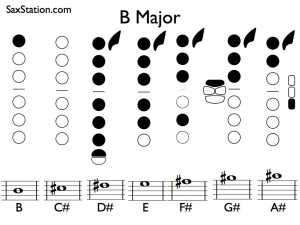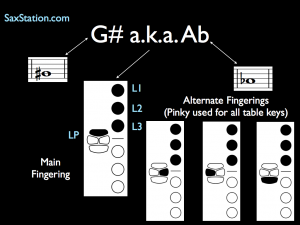Wayne asked me about what fork E is today.
How to Play Baker Street on Alto Sax – Saxophone Music
How to play the Baker Street alto sax line. Song by by Gerry Raferty (1978).
Originally played by Raphael Ravenscroft.
Baker Street is in Raphael Ravenscroft’s book but not in D major. So you could get that music and then transpose it (down a whole step) if you want. Or you could play it in the other key.
The glissando sounds like a D major scale to me. And to make it sound right, you’ll have to bend some notes.
Hope you like it!
How to Play Für Elise on Alto Sax!
Latest video lesson, Für Elise by Beethoven. Broken up into pieces. Let me know what you think!
Crazy Saxophone Technique! – Spok Frevo Orquestra – Três da Tarde (Lídio Macacão)
George Young sent me a link to this one. Pretty amazing technique!
Opens with the curved soprano sax player being featured, stay tuned until the end though.
ii V I? Introduction to the ii V I Progression for Saxophone Players
 You have probably heard of the ii V I progression if you play saxophone.
You have probably heard of the ii V I progression if you play saxophone.
Or if not….. it exists! I swear!
Cliff asked me about beginning ii V I stuff for Sax Station the other day.
He said, “I’m new to it so not sure what notes are involved, how to fit it into a melody, what it’s best used for etc…….I’ve just read that a good saxophonist needs to be familiar with it.”
At that point, I realized he had heard of the progression, but wasn’t too familiar with it, although he did know it could be important to know.
Here are some pieces you need to understand the basics of the ii V I progression.
If you have a ii V I in the key of C, then the notes in all three of those chords are the notes from the C major scale.
If you have a ii V I in the key of Bb, then the notes in all three of those chords are the notes from the Bb major scale.
The ii V I progression leads from one chord to the next to the last. There is tension and release. Resolution with the I chord.
There are also minor ii V i’s, but you can get into that later.
So, ii V and I refer to the different modes and chords that use the notes of the modes.
Let’s say you have a C major scale. It has seven notes in it. C, D, E, F, G, A, B.
If you had a number that corresponded to each of those notes, they would be 1, 2, 3, 4, 5, 6, 7
If you used roman numerals, they would be I, II, III, IV, V, VI, VII.
You can build chords upon each of those roots- triads, seventh chords, etc. Every other note is used in the chord, going up in thirds, so based on the root, the seventh chord would be C, E, G, B (in the key of C).
That would be a major chord. The I chord.
If you built a chord on D, using the notes in C major, it would be D, F, A, C. That would be a minor chord.
The roman numerals can be either capital or lower case. Capitals are used for major and dominant, lower case is used for minor. Half diminished, etc are also lower case and have other symbols.
The ii V I has a minor second chord, a dominant five chord, and a major I chord.
ii V I progressions happen in music, the notes used in the progression are the notes of the major scale of the I. Which notes you emphasize gives the color to the chords and sounds more ‘in’ the changes or ‘out’.
Playing a ii V I progression on the piano can help. And listening to music and recognizing when it comes up.
What other questions do you have about the ii V I progression? Leave a comment!
B Major Scale on Saxophone
Here’s another major scale for saxophone – B major. Has five sharps. F#, C#, G#, D#, A#
The links to a few others are below. I think I’ll include all these diagrams and possibly recorded examples within Saxophone Tribe and an upcoming beginning class on saxophone.
Saxophone Scales – C# Major Scale
Here it is, the ‘hardest’ scale for saxophone. Generally the keys with sharps are a little less familiar for saxophones than the keys with flats. And C# has a sharp on every note of the scale (all seven). Really, it’s just uncomfortable since we tend to play it …
Saxophone Scales – Ab Major Scale
Here’s the Ab major scale for saxophone. Ab sounds the same as G# and it’s sometimes more convenient to think about it as G#, but generally you want to think about it as Ab. There are four flats in the key of Ab.
G#/Ab is giving me trouble on sax! Why that happens, solutions
Got a question on here earlier about a sticky G# key from Katie on the saxophone fingering chart on Sax Station, she asked,
“Hey, I just started learning the sax. I have pretty much all the notes learned but G#/Ab is giving me trouble! According to the finger chart, you play a G but then add the left hand pinky. When I do this, it doesn’t change the G at all. Does it need repair?”
Since it’s an issue that likely comes up for most sax players, I thought I would turn my response into a post and elaborate a bit. Also ask for some ideas from you if you have some tricks.
There are four keys that your left pinky can press down, generally you’ll use the top one, although technically you could use the other keys in a pinch or if it comes out more cleanly in a situation.
If nothing moves when you press it, you probably have a ‘sticky pad’ on your sax. Other pads can get sticky too, but the G# key and maybe the bis key seem to be two prime culprits.
Because of the design of the saxophone, condensation and whatever goes into the saxophone gathers there. Regardless of the reasons, it happens. And when a key is sticking, notes you don’t mean to play can come out. And that can sound funky in a not so great way.
Sometimes it is just delayed because it’s sticky. But check to see what happens when you press the key. A button should rise up on the saxophone.
To keep it from getting sticky, just drink water while playing sax and don’t eat anything or drink anything with sugar right beforehand. Ideally you want to brush your teeth before you play.
Often times you can see what’s happening yourself and even use clean paper (ie a new bill) to slide along the pad and make it function better. If it’s really bad, you might need to go to a sax repair person.
Any thoughts?
Saxophone Scales – How to Play C Major Scale on Sax
The C major scale is often the one that we learn the first. Conceptually, it’s the easiest, no sharps, no flats. But it’s actually not the easiest to make sound good.
You can click on the image to see a larger version.
All of the major scales are on Saxophone Tribe.
It’s written out for just one octave here, but you should move into the full range of the saxophone when you’re able to do that.
Moving from C to D is probably the hardest transition within this scale. You’re moving from using a small section of the tube to most of it with the octave key, so those are two fairly different situations. You might want to spend some extra time going between those two notes to make sure it sounds good.
Let me know if you have questions.
Michael Brecker & Randy Brecker – Straphanging
The great Michael Brecker on tenor sax. Have been playing this song lately and enjoyed this recording of it, so figured I would post it.
Randy Brecker: Trumpet
Robben Ford: Guitar
George Duke: Keyboards
Alphonso Johnson: Bass
Peter Erskine: Drums
Been playing saxophone for a year or less?
What questions do you have about learning the saxophone?
The questions that advanced players and professionals have won’t necessarily be the ones that will help you. Although, if you’re addicted to saxophone, you might find them interesting anyway.
If you have been playing saxophone one year or less……
Do you have questions about buying a saxophone?
Getting a new mouthpiece?
Playing the extreme registers of the saxophone?
Improving your tone?
How to Play the Pink Panther Theme on Tenor Sax (First Line)
Here’s how to play the Pink Panther Theme (first line) by Henry Mancini. Talk a little about how I saw Plas Johnson, the sax man who originally recorded it.
It originally starts on an E# for tenor.
Sometimes it’s played in another key that’s a bit easier, starting on D# for tenor. Made a video for that key also that’s below the first video. In the second, you can see diagrams for all the notes. For the first video, if you’re not sure how to play some of the notes, check out the fingering chart on the downloads page
If you would like the sheet music for the Pink Panther theme and/or cartoon collection, check out the links.
Pink Panther Saxophone Quartet Arrangement
Pink Panther solo tenor sax music
The Pink Panther Classic Cartoon Collection
Original Key:
Easier Key:
And of course if you would like to hear the Pink Panther Theme by Plas Johnson himself, check out the Pink Panther Theme video.






